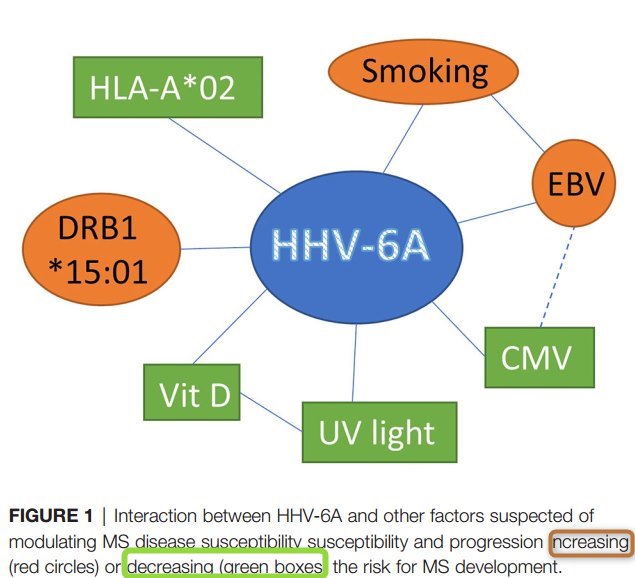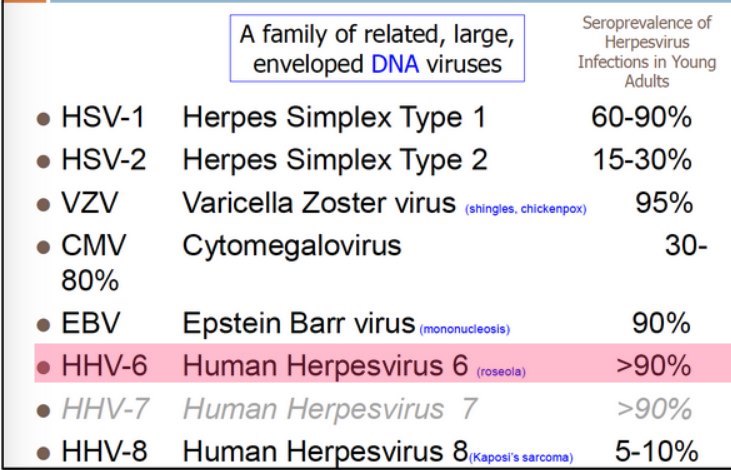Multiple Sclerosis Risk factors include virus such as Human Herpesvirus 6A – many studies
Human Herpesvirus 6A Is a Risk Factor for Multiple Sclerosis - 2022
Review Front Immunol . 2022 Feb 10;13:840753. doi: 10.3389/fimmu.2022.840753. eCollection 2022.
Wangko Lundström 1, Rasmus Gustafsson 1

The role for human herpesvirus (HHV)-6A or HHV-6B in multiple sclerosis (MS) pathogenesis has been controversial. Possibly because the damage of the virus infection may occur before onset of clinical symptoms and because it has been difficult to detect active infection and separate serological responses to HHV-6A or 6B. Recent studies report that in MS patients the serological response against HHV-6A is increased whereas it is decreased against HHV-6B. This effect seems to be even more pronounced in MS patients prior to diagnosis and supports previous studies postulating a predomination for HHV-6A in MS disease and suggests that the infection is important at early stages of the disease.
Furthermore, HHV-6A infection interacts with other factors suspected of modulating MS susceptibility and progression such as infection with
Epstein-Barr virus (EBV) and
Cytomegalovirus (CMV),
tobacco smoking,
HLA alleles,
UV irradiation and
vitamin D levels.
The multifactorial nature of MS and pathophysiological role for HHV-6A in inflammation and autoimmunity are discussed.
CONCLUSIONS - from PDF
Together, the studies compiled in this review suggest a role for HHV-6A in MS, particularly early in the disease course and/or at MS onset. This is based on findings of increased anti-HHV-6A antibody levels in people who developed MS later in life, compared to people who do not. HHV-6A infection interacts with other risk factors such as carriage of HLA-DRB115:01, tobacco smoking, low UV irradiation, low vitamin D levels and EBV infection; and with protective factors such carriage of the protective haplotype HLA-A02:01 and CMV infection. This shows the multifactorial nature of MS and suggests that accumulated burden of risk factors increases the risk for acquiring the disease. We propose a pathophysiological role for HHV-6A in induction of MS where an infection of the CNS leads to a primary injury and that this in turn leads to inflammatory events and autoimmunity.
📄 Download the PDF from VitaminDWiki
The role of herpesvirus 6A and 6B in multiple sclerosis and epilepsy - 2020
Scand J Immunol. 2020 Dec; 92(6): e12984 doi: 10.1111/sji.12984
Nicky Dunn, 1 , 2 Nastya Kharlamova, 1 , 2 and Anna Fogdell‐Hahncorresponding author 1 , 2
Human herpesvirus 6A (HHV‐6A) and 6B (HHV‐6B) are two closely related viruses that can infect cells of the central nervous system (CNS). The similarities between these viruses have made it difficult to separate them on serological level. The broad term HHV‐6 remains when referring to studies where the two species were not distinguished, and as such, the seroprevalence is over 90% in the adult population. HHV‐6B has been detected in up to 100% of infants with the primary infection roseola infantum, but less is known about the primary infection of HHV‐6A. Both viruses are neurotropic and have capacity to establish lifelong latency in cells of the central nervous system, with potential to reactivate and cause complications later in life. HHV‐6A infection has been associated with an increased risk of multiple sclerosis (MS), whereas HHV‐6B is indicated to be involved in pathogenesis of epilepsy. These two associations show how neurological diseases might be caused by viral infections, but as suggested here, through completely different molecular mechanisms, in an autoimmune disease, such as MS, by triggering an overreaction of the immune system and in epilepsy by hampering internal cellular functions when the immune system fails to eliminate the virus. Understanding the viral mechanisms of primary infection and reactivation and their spectrum of associated symptoms will aid our ability to diagnose, treat and prevent these severe and chronic diseases. This review explores the role of HHV‐6A and HHV‐6B specifically in MS and epilepsy, the evidence to date and the future directions of this field.
📄 Download the PDF from VitaminDWiki
Herpesviruses are extremely prevelant
Antibiotic, Antifungal, Antiviral Drugs - Herpesviruses

Human herpesvirus 6 "multiple sclerosis" 27,000 publications as of Feb 2022
hhv-6 Foundation
Autoimmune Disease
Cancer
Hodgkin’s Lymphoma
Gliomas
Cervical Cancer
Chronic Fatigue Syndrome
Cognitive Dysfunction
Delirium
Amnesia
Colitis/Diarrhea
Encephalitis
Encephalitis / Meningitis Overview
Encephalitis in the Immunocompromised
Encephalitis in the Immunocompetent
Rhomboencephalitis
Limbic Encephalitis
Encephalomyelitis
Amnesia
Endocrine Disorders
Epilepsy
Mesial/Temporal Lobe Epilepsy
Status Epilepticus
Heart Disease
Myocarditis
Left Ventricle Disfunction
Arteriopathies
Hemophagocytic Conditions
Hemophagocytic Syndrome/ Histiocytosis
HIV/AIDS Progression
Hypersensitiity (DIHS/DRESS)
Drug Induced Hypersensitivity Syndrome (DIHS)
Drug Reaction with Eosinophilia & Systemic Symptoms (DRESS)
Stevens-Johnson Syndrome (SJS)
Immune Suppression
Bone Marrow Suppression
Kidney Disease
Liver Disease
Hepatitis
HIV/AIDS Progression
Lung Disease
Organizing Pneumonia
Pneumonitis
Lymphadenopathy/Fever
Multiple Sclerosis
Evidence linking HHV-6 with multiple sclerosis: an update- 2014 📄 PDF
Rash & Roseola
Seizures
Febrile Seizures
Status Epilepticus
Transplant Complications
Bone marrow supression
Colitis/diarrhea
Delirium/CNS Dysfunction
Encephalitis/Amnesia
GVHD
Hemophagocytic syndrome
Hepatitis /Liver failure
Pneumonitis
Transplant Reactivation Overview
SIADH
Hypogammaglobulinemia
Optic Neuritis
Microangiopathy
Mononucleosis
Uveitis
Evidence linking HHV-6 with multiple sclerosis (2014) - cited by 111 studies as of Feb 2022
Google Scholar examples
Laboratory and clinical aspects of human herpesvirus 6 infections
Infection as an environmental trigger of multiple sclerosis disease exacerbation
Update on infections with human herpesviruses 6A, 6B, and 7
Presence of HHV-6A in endometrial epithelial cells from women with primary unexplained infertility
The role of infections in multiple sclerosis
Multiple sclerosis and neuroinflammation: the overview of current and prospective therapies
Contributions of neurotropic human herpesviruses herpes simplex virus 1 and human herpesvirus 6 to neurodegenerative disease pathology
Viruses and endogenous retroviruses in multiple sclerosis: From correlation to causation
VitaminDWiki - MS and Virus studies
This list is automatically updated
{category}
VitaminDWiki - Multiple Sclerosis 32 percent less likely among those with more than 32 ng of vitamin D – Dec 2019
{include}
VitaminDWiki - human herpesvirus are enveloped
Vitamin D TREATS Health problems: 40 ng ...150 ng
{include}
